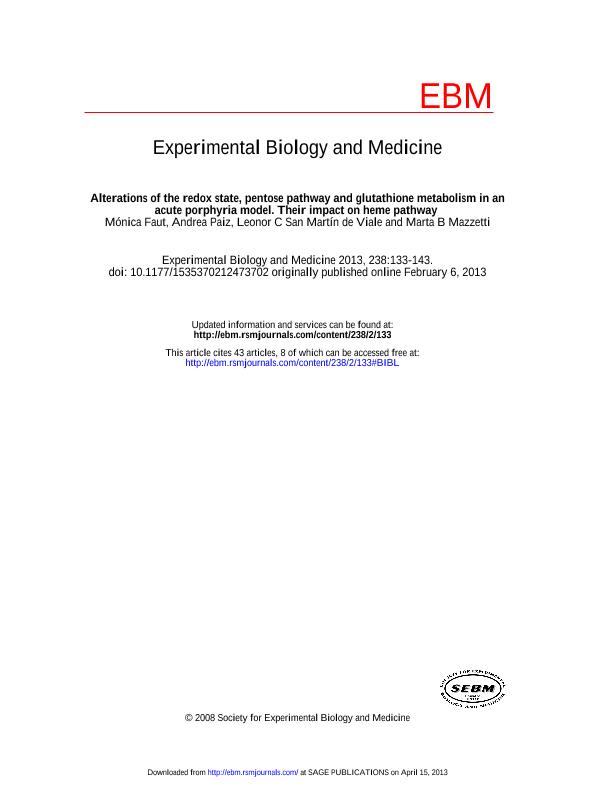Artículo
Alterations of the redox state, pentose pathway and glutathione metabolism in an acute porphyria model. Their impact on heme pathway
Fecha de publicación:
02/2013
Editorial:
Soc Experimental Biology Medicine
Revista:
Experimental Biology And Medicine
ISSN:
1535-3702
e-ISSN:
1535-3699
Idioma:
Inglés
Tipo de recurso:
Artículo publicado
Clasificación temática:
Resumen
A classical acute porphyria model in rats consists of combined treatment with 2-allyl-2-isopropylacetamide (AIA) and 3,5-diethoxycarbonyl-1,4-dihydrocollidine (DDC). The present work describes the effects of this treatment on the pentose phosphate (PP) pathway, glutahione metabolism and redox state and how they contribute to alter the glucose pool of hepatocytes and modulate porphyria, in Wistar rat livers. Our approach is based on the fact that glucose is a repressor of 5-aminolevulinic synthase (ALA-S), the rate-limiting enzyme of the heme pathway, and treatment with AIA/DCC causes oxidative stress. Different doses of the xenobiotcs were used. The results show that AIA (500 mg/kg body weight [BW])/ DDC (50 mg/kg [BW]) treatment increased glutathione peroxidase (GPx) activity by 46%, decreased both glutathione reductase (GR) and glutathione S-transferase (GST) activity by 69% and 52%, respectively, and reduced by 51% reduced glutathione (GSH) and increased by 100% glutathione disulfide (GSSG) concentrations, therefore lowering by four-fold the GSH/GSSG ratio. The activity of glucose-6-phosphate dehydrogenase (G6PD), the rate-limiting enzyme of PP-pathway, was increased by 129% as well as that of 6-phosphogluconate dehydrogenase. NADPH and the NADPH/NADP+ ratio were increased by 14% and 28%, respectively. These effects could be attributed to the generation of reactive oxygen species (ROS) elicited by the porphyrinogenic treatment, shown by enhanced DNA damage and ROS production. G6PD stimulation would decrease hepatic glucose concentrations and consequently exacerbate the porphyria. A decrease in glucose could stimulate ALA-S and this would add to the effect of drug-induced heme depletion. Since the key role of GST is to inactivate toxic compounds, the drastic fall in its activity together with the accumulation of ALA would account for the symptoms of this hepatic disease model. The present findings show the high metabolic interplay between pathways and constitute a relevant contribution to achieve a better treatment of acute human porphyria.
Palabras clave:
Porphyria
,
Glutathione Metabolism
,
Reactive Oxygen Species
,
Pentose Pathway
Archivos asociados
Licencia
Identificadores
Colecciones
Articulos(IQUIBICEN)
Articulos de INSTITUTO DE QUIMICA BIOLOGICA DE LA FACULTAD DE CS. EXACTAS Y NATURALES
Articulos de INSTITUTO DE QUIMICA BIOLOGICA DE LA FACULTAD DE CS. EXACTAS Y NATURALES
Citación
Faut, Monica; Paiz, Andrea; San Martin, Leonor Carmen; Mazzetti, Marta Blanca; Alterations of the redox state, pentose pathway and glutathione metabolism in an acute porphyria model. Their impact on heme pathway; Soc Experimental Biology Medicine; Experimental Biology And Medicine; 238; 2; 2-2013; 133-143
Compartir
Altmétricas




